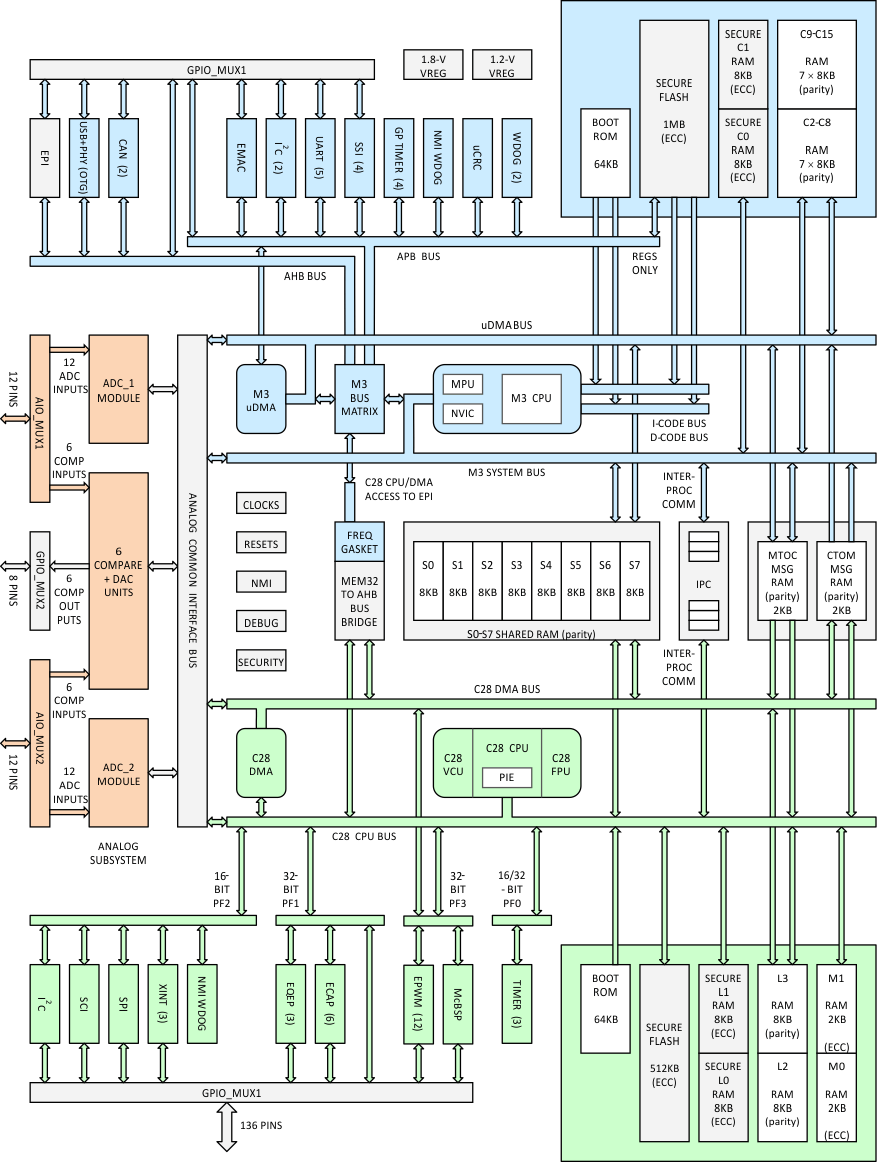ZHCSBK0D October 2012 – October 2015 F28M36H33B2 , F28M36H53B2 , F28M36P53C2 , F28M36P63C2
PRODUCTION DATA.
- 1器件概述
- 2修订历史记录
- 3Device Comparison
- 4Terminal Configuration and Functions
-
5Specifications
- 5.1 Absolute Maximum Ratings
- 5.2 ESD Ratings
- 5.3 Recommended Operating Conditions
- 5.4 Electrical Characteristics
- 5.5 Power Consumption Summary
- 5.6 Thermal Resistance Characteristics for ZWT Package (Revision 0 Silicon)
- 5.7 Thermal Resistance Characteristics for ZWT Package (Revision A Silicon)
- 5.8 Thermal Design Considerations
- 5.9 Timing and Switching Characteristics
- 5.10
Analog and Shared Peripherals
- 5.10.1 Analog-to-Digital Converter
- 5.10.2 Comparator + DAC Units
- 5.10.3 Interprocessor Communications
- 5.10.4 External Peripheral Interface
- 5.11 Master Subsystem Peripherals
- 5.12
Control Subsystem Peripherals
- 5.12.1 High-Resolution PWM and Enhanced PWM Modules
- 5.12.2 Enhanced Capture Module
- 5.12.3 Enhanced Quadrature Encoder Pulse Module
- 5.12.4 C28x Inter-Integrated Circuit Module
- 5.12.5 C28x Serial Communications Interface
- 5.12.6 C28x Serial Peripheral Interface
- 5.12.7 C28x Multichannel Buffered Serial Port
-
6Detailed Description
- 6.1 Memory Maps
- 6.2 Identification
- 6.3 Master Subsystem
- 6.4 Control Subsystem
- 6.5 Analog Subsystem
- 6.6 Master Subsystem NMIs
- 6.7 Control Subsystem NMIs
- 6.8 Resets
- 6.9 Internal Voltage Regulation and Power-On-Reset Functionality
- 6.10 Input Clocks and PLLs
- 6.11 Master Subsystem Clocking
- 6.12 Control Subsystem Clocking
- 6.13 Analog Subsystem Clocking
- 6.14 Shared Resources Clocking
- 6.15 Loss of Input Clock (NMI Watchdog Function)
- 6.16 GPIOs and Other Pins
- 6.17 Emulation/JTAG
- 6.18 Code Security Module
- 6.19 µCRC Module
- 7Applications, Implementation, and Layout
- 8器件和文档支持
- 9机械、封装和可订购信息
1 器件概述
Section 1.1:
1.1 特性
- 主控子系统 — ARM® Cortex®-M3
- 125MHz
- 嵌入式存储器
- 高达 1MB 闪存(纠错码 (ECC))
- 高达 128KB RAM(ECC 或奇偶校验)
- 高达 64KB 共享 RAM
- 2KB 处理器间通信 (IPC) 消息 RAM
- 五个通用异步收发器 (UART)
- 四个同步串行接口 (SSI)
和一个串行外设接口 (SPI) - 两个内部集成电路 (I2C)
- 通用串行总线如影随形 (USB-OTG) + 物理层 (PHY)
- 10/100 以太网 (ENET) 1588 介质独立接口 (MII)
- 两个控制器局域网 (D_CAN) 模块(引脚可引导)
- 32 通道微直接内存访问 (µDMA)
- 双重安全区域(每个区域 128 位密码)
- 外设接口 (EPI)
- 微循环冗余检验 (µCRC) 模块
- 四个通用定时器
- 两个看门狗定时器模块
- 字节序:小端序
- 计时
- 片上晶振振荡器和外部时钟输入
- 支持动态锁相环 (PLL) 比率变化
- 1.2V 数字、1.8V 模拟、3.3V I/O 设计
- 处理器间通信 (IPC)
- 32 个握手通道
- 四条通道生成 IPC 中断
- 可用于通过 IPC 消息 RAM 协调数据传输
- 多达 142 个独立可编程、复用通用输入/输出 (GPIO) 引脚
- 无毛刺脉冲 I/O
- 控制子系统 - TMS320C28x 32 位 CPU
- 150MHz
- C28x 内核硬件内置自检
- 嵌入式存储器
- 高达 512KB 闪存(纠错码 (ECC))
- 高达 36KB RAM(ECC 或奇偶校验)
- 高达 64KB 共享 RAM
- 2KB 处理器间通信 (IPC) 消息 RAM
- IEEE-754 单精度浮点单元 (FPU)
- Viterbi,复杂数学运算,循环冗余校验 (CRC) 单元 (VCU)
- 串行通信接口 (SCI)
- SPI
- I2C
- 6 通道直接内存访问(DMA)
- 12 个增强型脉宽调制器 (ePWM) 模块
- 24 个输出(16 个为高分辨率)
- 6 个 32 位增强型捕捉 (eCAP) 模块
- 3 个 32 位增强型正交编码器脉冲 (eQEP) 模块
- 多通道缓冲串行端口 (McBSP)
- EPI
- 一个安全区域(128 位密码)
- 三个 32 位定时器
- 字节序:小端序
- 模拟子系统
- 双 12 位模数转换器 (ADC)
- 高达 2.88MSPS
- 高达 24 个通道
- 四个采样与保持 (S/H) 电路
- 多达六个具有 10 位数模转换器 (DAC) 的比较器
- 封装
- 289 焊球 ZWT 全新细间距球栅阵列 (nFBGA)
- 温度选项:
- T:-40ºC 至 105ºC(结温)
- S:–40ºC 到 125ºC(结温)
- Q:–40ºC 到 125ºC(自然通风)
(针对汽车应用的 Q100 认证)
1.3 描述
Concerto 系列是一款多内核片上系统微控制器单元 (MCU),此控制器具有独立的通信和实时控制子系统。F28M36x 系列器件是 Concerto 产品的第二系列产品。
通信子系统基于符合行业标准的 32 位 ARM Cortex-M3 CPU,并且 具备 多种通信外设(包括以太网 1588、带有 PHY 的 USB OTG、控制器局域网 (CAN)、UART、SSI、I2C)以及一个外部接口。
实时控制子系统基于行业领先的 TI 专有 32 位 C28x 浮点 CPU,并且 具备 最为灵活而又高度精确的控制外设,其中包括具有故障保护功能的 ePWM、编码器和捕捉单元 - 全部由 TI 的 TMS320C2000™ Piccolo™和 Delfino™系列产品来执行。此外,C28-CPU 已得到增强,新增 VCU 指令加速器,能够实现高效的 Viterbi、复杂算术运算、16 位快速傅里叶变换 (FFT) 以及循环冗余校验 (CRC) 算法。
共享一个高速模拟子系统和补充 RAM 内存,还有片上电压稳压和冗余计时电路。安全考虑还包括纠错码 (ECC),奇偶校验和代码安全内存,以及辅助系统级工业安全认证的文档。
1.4 功能方框图
 Figure 1-1 功能框图
Figure 1-1 功能框图